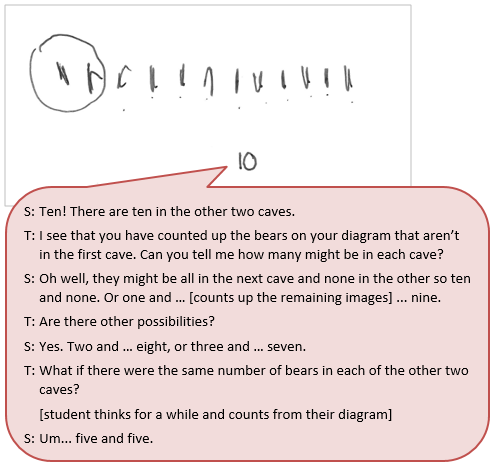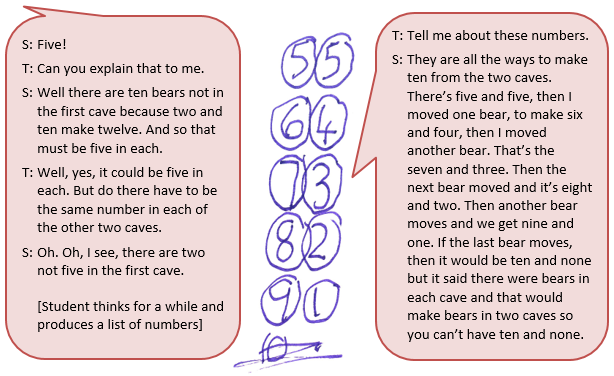The purpose of this activity is to engage students in problem solving to find an unknown addend.
This activity assumes the students have experience in the following areas:
- Counting forwards and backwards in ones from any number.
- Partitioning and regrouping numbers to make calculation efficient.
- Equally sharing whole number amounts.
The problem is sufficiently open ended to allow the students freedom of choice in their approach. It may be scaffolded with guidance that leads to a solution, and/or the students might be given the opportunity to solve the problem independently.
The example responses at the end of the resource give an indication of the kind of response to expect from students who approach the problem in particular ways.

There are three caves.
There are bears in each cave.
There are 12 bears altogether.
If there are 2 bears in the first cave, how many bears might be in each of the other caves?
Note to teacher: This activity requires materials for illustration. The ‘bears’ could be counters or buttons, the caves could be paper cups.
The following prompts illustrate how this activity can be structured around the phases of the Mathematics Investigation Cycle.
Make sense
Introduce the problem. Allow students time to read it and discuss in pairs or small groups.
- Do I understand what I need to do? (Find the number of bears in each of the two caves, allowing for the first cave having 2 bears.)
- Do I understand the meaning of the words? (The words ‘altogether’ and ‘each’ may need explanation.)
- What maths will be useful to solve this problem?
- What will an answer look like? (The answer will be numbers of bears that might be in the other two caves. It must also include clear description and justification about how the answers were found.)
Plan approach
Discuss ideas about how to solve the problem. Emphasise that, in the planning phase, you want students to say how they would solve the problem, not to actually solve it.
- What strategies will be useful to solve a problem like this? (Acting out, drawing a diagram, making a physical model, and writing number pairs are all possible strategies.)
- Do I have some idea of how many answers there might be? How do I know that?
- What numbers and operations will I use? How might I record those operations? (Addition expressions are a good way to represent the numbers of bears in each cave.)
- What tools (digital or physical) could help my investigation?
Take action
Allow students time to work through their strategy and find a solution to the problem.
- What is my strategy? Is it working or do I need to change?
- Have a tried some numbers to find some that work?
- Have I shown my workings in a step-by-step way?
- Is there a pattern? Can I use the pattern to find more number pairs?
- How can I express my solution using diagrams, numbers, and words?
- Have I used the most efficient way to solve the problem?
Convince yourself and others
Allow students time to check their answers and then either have them pair share with other groups or ask for volunteers to share their solution with the class.
- Is my working clear for someone else to follow?
- How would I convince someone else I am correct?
- Have I found all the possible numbers of bears in each cave? How do I know that I have not missed any possible answers?
- What would the answers be if I changed the total number of bears?
- Can I come up with a general strategy that works on these kinds of problems?
Examples of work
Work sample 1
The student use images and/or objects to represent the bears to be distributed. By changing the partitions of the ten they create a solution set of possible number pairs.
Click on the image to enlarge it. Click again to close.
Work sample 2
The student uses symbolic representation of the possible number pairs and relates the pairs back to the bear context.

